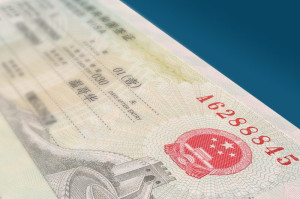 Last week the Ministry of Foreign Affairs issued a bilingual notice that spells out China’s new visa structure.
Last week the Ministry of Foreign Affairs issued a bilingual notice that spells out China’s new visa structure.
Beijing-based immigration lawyer Gary Chodorow has published an article highlighting some of recent changes in the Chinese visa structure in an easy-to-read layout.
The post breaks down the most common visas, explaining both what the previous law and the new statue/regulations are, as well as providing some helpful analysis on the new regs. Here are two examples:
L Visas (Tourism)
Previous law: L visas were issued for tourism, to visit relatives, or for other private purposes.
New statute/regulations: Now, L visas are exclusively for tourism. Persons coming to China to visit relatives or for other private purposes will now apply for Q or S visas.
The draft State Council regulations would have required that round-airlines tickets and hotel reservations be provided in every case, but that requirement was dropped in the final regulations.MFA notice: Applicants must submit either their travel itinerary, including round-trip air reservations, hotel reservations, “etc.†or an invitation letter issued by an entity or individual in China identifying the applicant (full name, gender, date of birth, etc.), describing the planned visit (arrival and departure dates, places to be visited, etc.), and identifying the entity or individual providing the invitation (name, contact telephone number, address, the entity’s official stamp, signature of the legal representative of the entity or the individual).
Analysis: Thankfully the MFA notice is not as strict as the draft regulations, which would have required every applicant to purchasing tickets (票) before applying for the visa. Still, a consular officer has the authority to require this on a case-by-case basis.
M Visas (Business or Commerce)
Previous law: There was no prior M visa classification. F visas covered visitors for business or commerce.
New statute/regulations: M visas will be issued to persons who come for business or commercial activities. Key evidence includes an invitation letter issued by a Mainland China trading or business partner.
MFA notice: Applicants should submit one of the following:
- documentation of the commercial activity issued by a trade partner in China;
- trade fair invitation; or
- invitation letter issued by an entity or individual, with information about the applicant (full name, gender, date of birth, etc.), the planned visit (purpose of visit, arrival and departure dates, places to be visited, relationship between the applicant and the inviting entity or individual, source of financial support for the trip), and the entity or individual providing the invitation (name, contact telephone number, address, entity’s official stamp, signature of the entity’s legal representative or the individual).
Analysis: Although not explicitly reflected in the MFA notice, the intent of the new Exit-Entry Administration Law is to draw a clearer line between permitted business and commercial activities with an M visa and prohibited employment. See generally Q&A on China’s New Exit-Entry Administration Law and Regulations.
Applicants will need further guidance from the government about how to distinguish proper activities for F versus M visas.Prior practice was for consulates to accept either an invitation letter from an entity like a company or an invitation letter from a “duly authorized unit†of government (被授æƒå•ä½), such as a local bureau of human resources and social security. The latter were often helpful in obtaining multiple entry visas valid for longer stays in China. It’s unclear whether omission of these letters from the MFA announcement was intended to show they’ve fallen into disfavor.
Here is a quick reference chart that we published previously to help give you an at-a-glance overview of the new visa structure. Note: this was constructed from data available at the time, and may not reflect the current visa structure. We will update as soon as possible:









Careful here. The proposed Z1 and Z2 visa categories were NOT included in the final draft released on 1st September.
Good point Chris. I’ll have to go back and adjust the chart when I have some free time. I’ve updated the text of the post to reflect.
Great info, thanks. There was a lot of conjecture on this – glad to see it spelled out. I renew in December – I hope all is clear by then.
Pingback: Visas Questions | Hohhot - an online home for foreigners in the Blue City
Good to see an update on the China visa issue. While I was in China it caused the most paranoia among teachers and IELTS examiners.
How might this effect people who’ve got the border-jumper, HK-issued F visas?